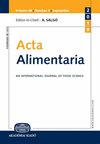Impact of technological operations on oxygen consumption during wine production
IF 1
4区 农林科学
Q4 FOOD SCIENCE & TECHNOLOGY
引用次数: 0
Abstract
Oxygen plays a crucial role in all stages of wine production. The aim of this study was to quantify dissolved oxygen in filtered wines trained on fine lees during different technological operations such as racking, coarse filtration, stabilisation of thermolabile proteins, and sterile filtration and bottling. The most significant oxygenation of wine occurs during filtration (1.9–3.57 mg L−1) and during bottling (2.99–4.12 mg L−1). At the same time, oxygen affects the phenolic composition, antioxidant activity and sulphur dioxide.Understanding and being able to use oxygen correctly during wine production can lead to a reduction in the doses of sulphur dioxide used. It has been shown that wines trained on fine lees are more able to withstand oxygen and, therefore, the sulphur dioxide doses can be reduced substantially. The experiment, in which two different winemaking technologies were observed, was carried out on the Welschriesling variety using both stainless steel tanks and oak barrels.工艺操作对葡萄酒生产耗氧量的影响
氧气在葡萄酒生产的各个阶段都起着至关重要的作用。这项研究的目的是量化在不同的技术操作过程中,在细酒糟上培养的过滤葡萄酒中的溶解氧,如发酵、粗过滤、不耐热蛋白质的稳定以及无菌过滤和装瓶。葡萄酒最显著的氧化作用发生在过滤过程中(1.9–3.57 毫克 L−1)和装瓶期间(2.99–4.12 毫克 L−1)。同时,氧影响酚类成分、抗氧化活性和二氧化硫。在葡萄酒生产过程中,了解并能够正确使用氧气可以减少二氧化硫的使用量。研究表明,用优质酒糟酿造的葡萄酒更能耐受氧气,因此,二氧化硫的剂量可以大幅减少。实验中观察了两种不同的酿酒技术,使用不锈钢罐和橡木桶对Welschriesling品种进行了研究。
本文章由计算机程序翻译,如有差异,请以英文原文为准。
求助全文
约1分钟内获得全文
求助全文
来源期刊

Acta Alimentaria
农林科学-食品科技
CiteScore
1.80
自引率
0.00%
发文量
47
审稿时长
18-36 weeks
期刊介绍:
Acta Alimentaria publishes original papers and reviews on food science (physics, physical chemistry, chemistry, analysis, biology, microbiology, enzymology, engineering, instrumentation, automation and economics of foods, food production and food technology, food quality, post-harvest treatments, food safety and nutrition).
 求助内容:
求助内容: 应助结果提醒方式:
应助结果提醒方式:


